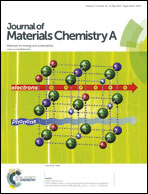Tuning the crystallinity parameters in macroporous titania films†
Abstract
Although macroporous titania scaffolds are used for many different applications, not much is known about the importance of the synthesis strategy on the resulting materials' properties. We present a comparative study on the influence of different colloidal titania precursors for direct co-deposition with poly(methyl methacrylate) (PMMA) beads on the properties of the resulting macroporous scaffolds after calcination. The colloidal titania precursors for the film assembly differ in their size and initial crystallinity, ranging from amorphous sol–gel clusters to already crystalline pre-formed particles of 4 nm, 6 nm and 20 nm in size, as well as a combination of sol–gel and nanoparticle precursors in the so-called ‘Brick and Mortar’ approach. The type of the precursor greatly influences the morphology, texture and the specific crystallinity parameters of the macroporous titania scaffolds after calcination such as the size of the crystalline domains, packing density of the crystallites in the macroporous walls and interconnectivity between the crystals. Moreover, the texture and the crystallinity of the films can be tuned by post-synthesis processing of the films such as calcination at different temperatures, which can be also preceded by a hydrothermal treatment. The ability to adjust the porosity, the total surface area and the crystallinity parameters of the crystalline macroporous films by selecting suitable precursors and by applying different post-synthetic treatments provides useful tools to optimize the film properties for different applications.


 Please wait while we load your content...
Please wait while we load your content...